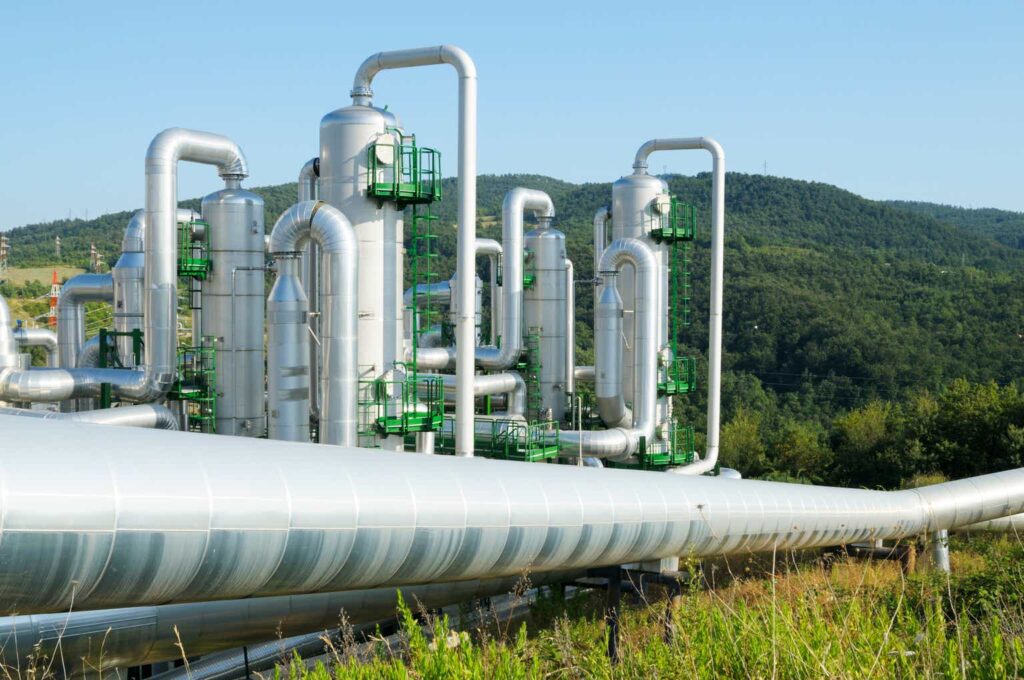EGS (Enhanced Geothermal Systems) technology has been under development for decades, but progress has been limited as it is an extremely challenging problem, both from a technical and economic perspective. While progress is being made, there are still issues that need to be resolved before the technology is commercialized.
While the future of the technology is still uncertain, the commercialization of EGS could provide benefits to a range of companies, including oilfield services companies, power companies and equipment manufacturers. The size of the opportunity is unlikely to be meaningful for most of these companies though.
Ormat Technologies (NYSE:ORA) is a potentially interesting way to gain exposure to EGS, despite the fact that the company isn’t currently involved in any EGS projects. Ormat both operates and provides equipment for conventional geothermal power plants, providing multiple potential revenue streams if EGS takes off.
Geothermal
Geothermal is a clean source of energy that is differentiated by the fact that it can provide base load power. Conventional geothermal is limited though as hydrothermal resources with the requisite properties (water, heat, flow paths) are relatively rare.
EGS projects extract heat from deep formations that lack the permeability or fluid saturation found in naturally occurring geothermal systems. Hydraulic fracturing is used to enhance flow paths in the formation, allowing heat to be extracted from resources that would otherwise be considered unrecoverable. EGS could facilitate access to over 100 GW of energy, far more than conventional geothermal capacity.
A range of EGS pilot projects have been conducted over the past 50 years in countries like the UK, the US, France, Germany and Australia. So far commercialization of EGS has been hampered by high costs and difficulty drilling and establishing flow paths between injection and production wells.
Technical Challenges
Technical challenges can be broadly broken into subsurface and surface categories.
Subsurface
Geothermal uses heat extracted from the reservoir to power a steam cycle. In EGS, this typically involves creating a fracture system in the reservoir which allows heat to be effectively transferred to a fluid flowing through the reservoir. While this is similar to tight oil and gas production in many ways, and uses similar technology, there are key differences.
EGS requires high bottomhole temperatures to drive efficient energy production. This is a challenge for subsurface operations as most downhole equipment, fluid systems, etc. are not designed to operate at a temperature above something like 175 degrees Celsius. EGS often involves temperatures in excess of 200 degrees Celsius, which necessitates specialized equipment and increases costs exponentially.
The need for high bottomhole temperatures also means that well depths are extreme, even in areas where temperature gradients are far greater than normal. Along with temperature, depth contributes to high well costs. It also limits the areas where EGS is feasible to locations with high temperature gradients. This may not necessarily be a large issue, but it can increase the cost of operating a facility and building infrastructure to connect to the electricity network. In areas with normal temperature gradients, well depths are at the limits of existing technology and extremely expensive.
Efficiently extracting heat from a reservoir typically requires enhancing the productivity of the reservoir using hydraulic fracturing. In some ways this is similar to the use of hydraulic fracturing in oil and gas, but there are key differences. Hydraulic fracturing in oil and gas involves pumping a fluid at high pressures to fracture the reservoir. The face of the fracture is either etched with an acid or held open with a proppant so that it retains permeability after pumping stops. Fracking may be performed in higher permeability formations to try and reduce the near wellbore pressure loss caused by radial flow convergence, or in lower permeability formations to increase the surface area of the formation in direct contact with the wellbore.
Figure 1: Hydraulic Fracturing to Enhance Reservoir Productivity (source: Created by author)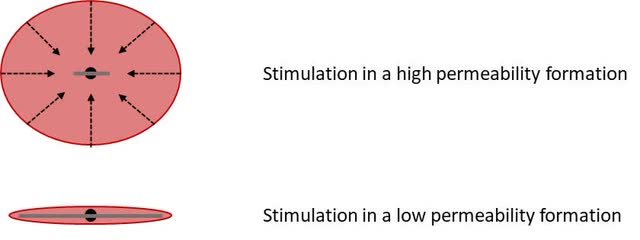
This concept has been taken to the extreme in shale formations where horizontal wells are drilled and many frac stages placed along the lateral, with multiple perf clusters in each stage. There is a limit to how densely a formation can be effectively fractured though, as each fracture creates a stress shadow, preventing the propagation of multiple fractures in close proximity.
Figure 2: Multi-Stage Fracturing in Horizontal Wells (source: Created by author)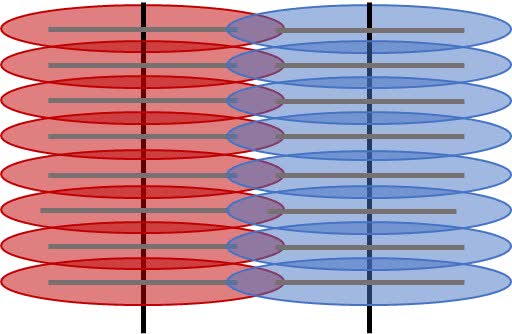
In EGS the goal is to extract heat rather than a fluid, changing the objective of reservoir stimulation. The fracture network would ideally made up of narrow and complex fractures which maximize both surface area and convective heat transfer. There is a tradeoff though, as narrow and complex fractures increase pressure loss between the injection and production well, which requires more energy to pump fluid through the system.
A traditional frac job is unlikely to meet these objectives as the geomechanics in most reservoirs tends to lead to fairly simple fracs (vertical in one direction) and there is little that can be done to change this. A worst-case scenario would involve a fracture directly connecting the injection and production well, with fluid flowing rapidly between the two and limited heat transfer occurring.
Shear dilation has been proposed as an alternative means of increasing reservoir permeability without directly connecting the injection and production wells. This involves pumping fluids into the formation at low rates over an extended time period (days to weeks versus a few hours for a normal frac job). The goal being to slowly raise the pressure in the formation so that pre-existing faults begin to fail throughout the reservoir, without pressure increasing to the point that a fracture is induced.
The use of proppant in an EGS well is also somewhat of an unknown. Proppant can help ensure a fracture retains permeability after a frac job is completed. In an EGS system, downhole pressures may be sufficient to hold a fracture open, negating the need for proppant. High flow rates through a fracture system also risk causing proppant to be displaced through the production well. In addition, the permeability of a proppant pack is likely to degrade significantly over time due to diagenesis and the effect of the high temperatures on proppant strength.
There is also the question of whether to drill horizontal wells, and if so where to drill the lateral. A horizontal well increases contact with the reservoir and potentially reduces the uncertainty of intercepting the fracture network with a production well. Directional drilling increases costs significantly though, due to both the depth and temperatures involved.
If horizontal wells are drilled, they must have the correct orientation, depth and offset to ensure that fractures propagate in the desired direction and effectively connect the injection and production wells. Wellbore breakout data can provide a guide as to the stress orientation in the reservoir and the likely direction of fracture propagation. Modelling software is also available which can provide an estimate of the likely length and height of a fracture, but without calibration from real-world data, modelling may be highly inaccurate.
Microseismic monitoring is the best means of determining the size and orientation of a fracture, but even with this it must be kept in mind that it is only a guide. Due to the frequency of seismicity caused by failure at the fracture tip, it is not possible to directly measure the propagation of a fracture. Rather, fracturing changes the stress field in a reservoir, leading to seismic events occurring near the fracture. These microseismic events can be used to guide the placement of a production well, but as it is not a direct measurement of fractures in the reservoir, there is uncertainty.
Figure 3: Fracturing in an EGS Well (source: Created by author)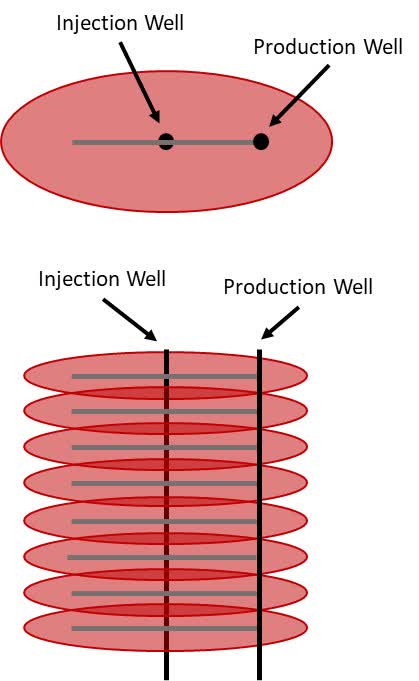
Even after an effective fracture network connecting an injection and production well is created, there is still uncertainty about how the system will perform over time, due to factors like:
- Scale forming in the fracture network and wellbores
- Corrosion of casing due to high temperatures and brine
- Time taken for the reservoir temperature to decline to a point where energy production is no longer efficient.
Surface
The primary surface issue of EGS is the relatively low temperatures involved, which makes electricity production from heat inefficient. It also means that water is generally inappropriate as the working fluid in the power plant as it will condense in the turbine, causing damage. An alternative fluid like a refrigerant is necessary to avoid this, but this can increase costs. This is a fairly well understood problem though, and approaches like the Kalina cycle help to minimize the problems caused by low temperatures. This is relevant to Ormat, as it already has equipment (air-cooled binary power plants utilizing organic Rankine cycles) suited to these conditions due to its involvement in traditional geothermal energy.
Economic Challenges
Even if a technically viable plant can be created, where fluid flows from an injection well to a production well and effectively extracts heat from the subsurface, economic viability must still be established.
A relatively large amount of fluid needs to be pumped through the subsurface system, which could be expensive. Energy requirements are dependent on both the required pressure and rate. High pressures can also be problematic as it necessitates the use of specialized and expensive equipment. An effective fracture system will help to reduce pressure requirements, but this may come at the expense of less effective heat transfer in the reservoir.
It should be noted that there is a natural thermosiphon effect which should help to limit pumping pressures. This is because fluid is injected at a low temperature and high pressure and produced at a high temperature and low pressure. This means that the fluid in the injection well is denser than the fluid in the production well, providing a natural pressure differential.
EGS may also be economically marginal due to the low temperatures being used to produce energy. This is naturally inefficient and necessitates the use of specialized equipment. The location of high-potential geothermal resources may also mean that there is a lack of water available for cooling. Air-cooled power plants are less efficient and more expensive, particularly if ambient temperatures are high. In addition, the cost of connecting production facilities to existing electricity transmission infrastructure may be high.
Given all of these technical and economic hurdles, it is unsurprising that progress in commercializing EGS has been slow. Governments are supportive due to climate change concerns though, and the shale revolution has led to subsurface technology improvements which have made the concept more feasible.
Utah Forge
The Department of Energy is providing significant support for the development of EGS through Energy Earthshot. This initiative aims to reduce the cost of EGS to 45 USD per MWh by 2035, a 90% reduction from current levels.
The DOE has been exploring EGS since 2015 at the Utah Frontier Observatory for Research in Geothermal Energy (FORGE). Utah Forge enables R&D to identify a replicable, commercial pathway to EGS. The primary objective of the project is to work out how to initiate and sustain fracture networks in basement rock formations.
A deviated injection well was drilled at the site to a total depth of 10,987 feet, with the well completed in 84 days (~40% faster than planned). The well’s vertical depth is 8,561 feet and its bottomhole temperature exceeds 440 degrees Fahrenheit. A three stage frac job was completed at the site in 2022, with between 3,000 and 4,000 barrels of water injected. Drilling of a production well targeting a total depth of 10,697 feet began in April 2023. This is one of the more critical steps in the operation as the production well must intercept the fracture network of the injection well.
Companies
Investors can gain exposure to EGS through:
- Companies providing wellsite services
- Power plant equipment manufacturers
- Power producers
- Oil and gas companies
Given the size of many of the companies in these segments, there may be little upside, even if the technology is commercially deployed.
Enel
Enel (OTCPK:ENLAY) is a clean energy utility company that is a partner in the Forge project. Through its Enel Green Power business line, Enel operates 64 wind, geothermal and solar plants with a managed capacity of over 7.6 GW. Enel Green Power has 875 MW of installed geothermal capacity, making it one of the world’s leaders in this technology.
Fervo Energy
Fervo is a private company that is focused on developing EGS technology. The company recently demonstrated high flow rates between an injection and a production well, and believes it has a clear line of site to achieving commercial power production.
Fervo recently completed a successful flow test between injection and production wells at a site in Utah. The company believes that its Project Red is the most productive EGS project in history. The 30-day well test achieved a flowrate of 63 liters per second at temperatures sufficient to generate 3.5 MW of electricity.
Fervo drilled a pair of horizontal wells with lateral lengths of 3,250 feet. The bottomhole temperate of these wells was 191 degrees Celsius. Both the injection and production wells were stimulated. 16 stages were pumped on the injection well with a high rate slickwater design used. Fervo’s next horizontal well pair is planned to achieve more than double the power output of the pilot design.
Oil and Gas Companies
A number of oil and gas companies have been trying to gain exposure to EGS, as it would diversify their revenue while leveraging many of their core competencies.
Devon (DVN) has invested 10 million USD in Fervo Energy and Baker Hughes (BKR) has formed a partnership with Continental Resources and Chesapeake Energy (CHK). This partnership is focused on technology to transform abandoned oil and gas wells into geothermal wells.
Drilling companies and oilfield services companies will also naturally have exposure, although activity is likely to be low relative to onshore oil and gas in North America. Drilling companies probably offer more upside due to the technical difficulty of drilling deep horizontal wells through high temperature basement formations.
Ormat
Ormat has previously dabbled in enhancing the productivity of conventional geothermal fields using stimulation. Ormat increased power output within an operating geothermal field at Desert Peak by 38% using stimulation to increase well injectivity to commercial levels. Injection rates of up to 1,600 gallons per minute were achieved without consuming or discharging water at the surface and using only existing geothermal brine returned to the original aquifer.
Ormat isn’t involved with any EGS projects at the moment, but if EGS became viable it is likely the company would choose to leverage its expertise and participate. Even if it does not, Ormat should benefit from the sale of geothermal equipment to companies that do.
Ormat operates several related segments:
- Electricity – Ormat operates geothermal, solar and recovered energy based power plants
- Product – Ormat manufactures equipment for geothermal and recovered energy power plants
- Energy Storage
Table 1: Ormat Revenue Contribution by Segment (source: Ormat)
Ormat is the second largest geothermal owner and operator, with 16 GW of installed geothermal capacity globally. The company believes penetration is still low though, with global potential 9x the current installed capacity.
Figure 4: Geothermal Installed Capacity (source: Ormat)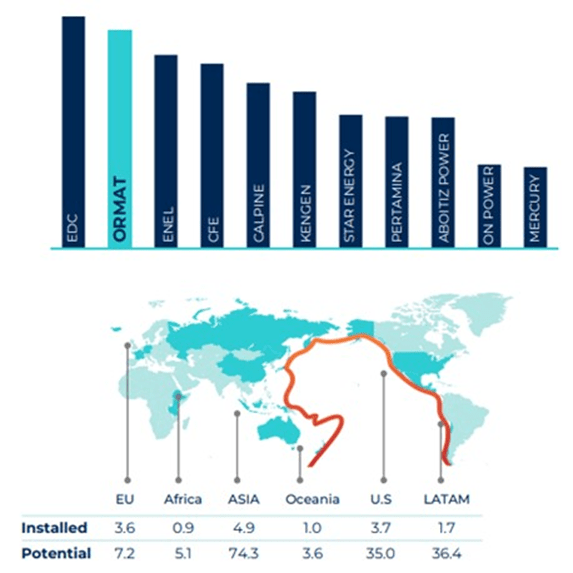
Ormat is also a leading provider of geothermal power plant equipment, having built approximately 190 power plants with 3,200 MW of installed capacity. Ormat’s air-cooled binary power plants are the technology of choice for EGS developments.
Figure 5: Suppliers of Geothermal Power Plants 2018-2022 (source: Ormat)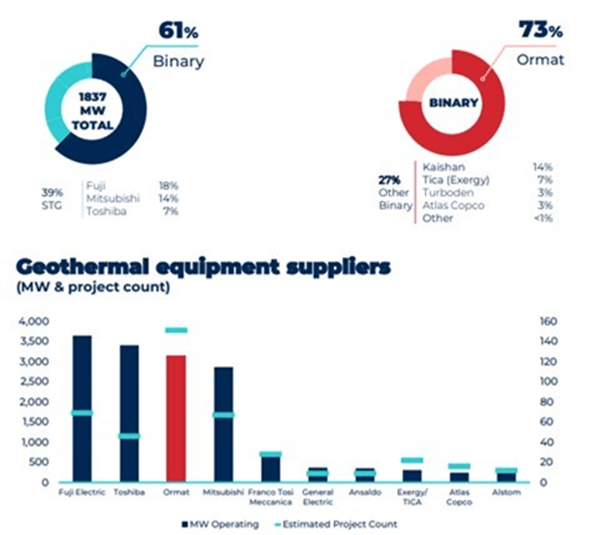
Conclusion
Ormat has a demonstrated history of solid growth and profitability, and given industry tailwinds, this is likely to continue going forward. While EGS is still a technology with a highly uncertain future, widespread commercialization would dramatically increase Ormat’s opportunity.
While Ormat has a solid business, it is also capital intensive and growth is relatively low. I tend to think its stock should be worth around 50 USD per share, with EGS potentially providing around 10 USD per share upside on a risk adjusted basis.
An argument could therefore be made that Ormat’s stock is now fairly valued, but I would expect the stock to gravitate towards 50 USD per share in the near term, just on a technical basis. The stock could potentially fall to around 40 USD per share if the PE ratio returns to more historically normal levels. This would be a far more attractive entry point, as the stock would likely outperform the market over the long term (regardless of EGS) with EGS providing substantial upside.
Figure 6: Ormat PE Ratio (source: Seeking Alpha)
Read the full article here


